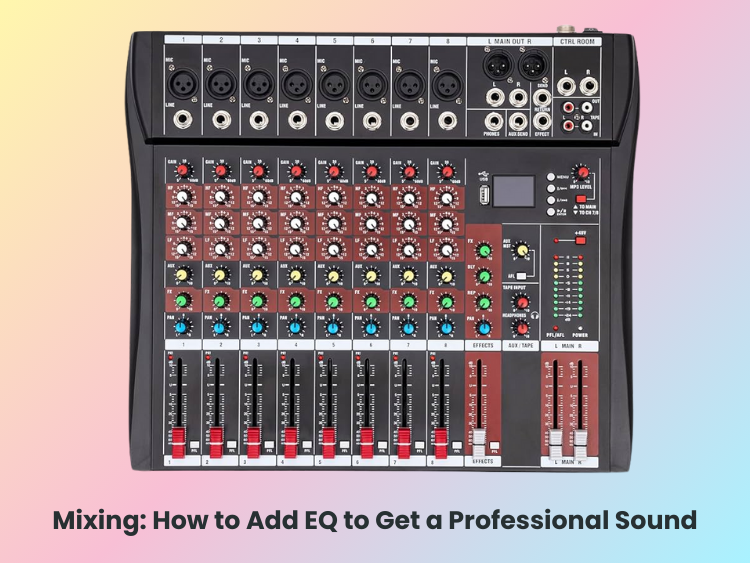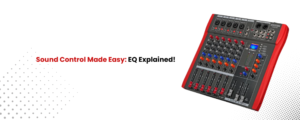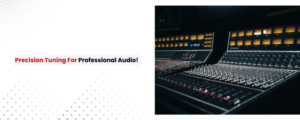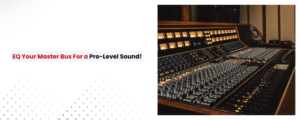Equalization (EQ) is one of the most important tools in audio mixing. You can change the frequency balance of a sound this way, which makes a mix clearer, warmer, and deeper. EQ can make the difference between a track that sounds amateurish and one that sounds expert. Find out how to get the most out of EQ in this guide. It will help you get that smooth, professional sound.
Types of EQ Filters
- HP-filter (High-pass filter): Below some frequencies, remove low frequencies.
- Low-pass filter (LPF): Removes higher frequencies above a certain threshold.
- Shelf filter: Increases or decreases frequencies above or below a certain frequency.
- Bell curve filter: Aimed at a certain frequency range for more precise adjustments.
- Notch filter: Attenuates a very narrow band of frequencies, which is useful for removing noise.
Applying EQ for a Professional Mix
1. High-Pass Filtering for Clarity
For most guitar, voice, and other instruments we have a lot of low end frequencies unnecessary. Using a high-pass filter (HPF) on tracks that aren’t meant to have bass, like vocals, guitars, and cymbals, removes any unwanted rumble and prevents muddiness in the mix.
For example:
- Vocals: Apply an HPF at around 80-100Hz.
- Acoustic guitars: Use an HPF of around 100-150Hz.
- Hi-hats and cymbals: Use an HPF at 200Hz or higher to eliminate unwanted low-end.
2. Controlling the Low Mids to Avoid Muddiness
The 200Hz – 500Hz range, where a mix can become muddy if not controlled. Cutting some of these frequencies here cleans up the mix yet still keeps it warm.
- To eliminate a boxy sound in voices, cut 250Hz – 400Hz.
- If bass guitars sound too boister, cut 300Hz.
- In snare drums, change 400Hz – 500Hz to eliminate too much body without sacrificing impact.
3. Enhancing Presence in the Midrange
The midrange is crucial because it contains most of the audible details in a mix. Enhancing this area properly ensures clarity and separation between instruments.
- Increase clarity in voices by boosting 1 kHz to 2 kHz.
- In guitars and keyboards, somewhat trim 500Hz – 1 kHz to create vocal space.
- To provide the snare and kick attack, raise 1 kHz to 2 kHz in drums.
4. Adding Definition with Upper Mids
The 2kHz – 6kHz range gives tracks a presence that makes them stand out in the mix.
- To increase intelligibility in voices, boost 3kHz – 5kHz.
- In guitars, raise 2 kHz–4 kHz to improve attack and brightness.
- To create crispness in snare drums, boost 4 kHz – 6 kHz.
5. Bringing Air and Shine with High Frequencies
The 6kHz – 20kHz range is where the sparkle and openness of a mix reside. However, excessive boosting can lead to harshness.
- In voices, boost 8 kHz – 12 kHz for a breathy quality.
- To enhance shimmer, raise cymbals’ 10 kHz–16 kHz range.
- For a general airiness in the master sound, somewhat increase 12 kHz – 18 kHz.
Common EQ Mistakes and How to Avoid Them
1. Over-Boosting Frequencies
A common error is over-boosting that will result in a mix sounding unnatural. Never boost, make space by carving out unwanted frequencies for things to pop out.
2. Ignoring the Importance of Subtractive EQ
Instead of making over the top boosts trying to attain more clarity, subtractive EQ (removing unwanted frequencies) gives a mix room to breathe. For instance, eliminating 250Hz on vocals can result in them sounding much clearer, without having to add more highs.
3. Not Using Reference Tracks
An effective way of making sure you’re not over or under tonal somewhere in the spectrum is to reference your mix against a professionally mixed track of the same style and genre.
4. Applying EQ in Solo Mode Too Often
Soloing the part you want to EQ helps to find collisions in the mix, but always make EQ decisions with the full mix playing.
Finalizing Your Mix with EQ on the Master Bus
Applying small EQ changes on the master track can help bind everything together after all separate parts are EQ’d:
- A slight increase for warmth between 50Hz and 80Hz.
- To get muckiness out, cut gently between 200Hz and 300Hz.
- For clarity, a little increase between 3 kHz and 5 kHz
- A touch of high-shelf boost for openness between 10 kHz and 16 kHz.
Conclusion
EQ is a crucial element of a professional sounding mix. Understanding frequency ranges, using subtractive EQ to our advantage, and boosting intelligentlyallows you to create a balanced, polished sound. Whether you’re mixing on vocals, instruments, or entire tracks, by taking a strategic approach to EQ, you will be able to achieve clarity, depth, and cohesion in your final mix.




